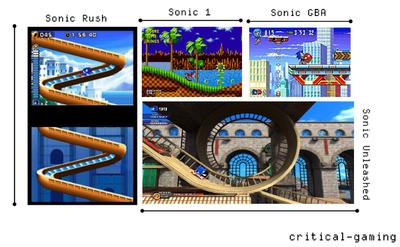Let's face it. Sonic has not aged in the same way that Mario has. The latest console games Sonic Unleashed and Sonic and the Secret Rings are sloppy at best. In fact, none of the Sonic games are as finely crafted as Super Mario Brothers for the NES. Even the Sonic Rush Adventure, my favorite Sonic game, leans too far to the side of manic, fast action gameplay with abstract mechanics for my tastes. Sega has attempted to make each next-gen Sonic game the one that "returns to form," but I don't think that's possible. Not only are the developers making mistake after mistake in terms of game design, but they're constantly chasing after a new "cool Sonic" resulting in Sonic going through a sort of pop culture "flavor of the week" with every game. Check out some of the flavors below.
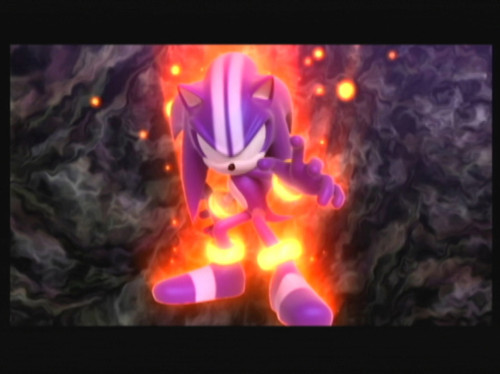
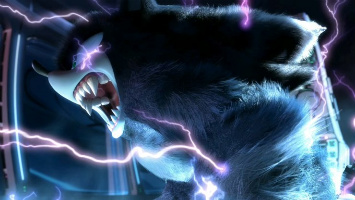

What's cool about Sonic is simple. What of the core design needs repair and how to do it is more complicated. The purpose of this article, the 4th and final article in this series, is to highlight the essence of Sonic and to lay down the foundations of a fully repaired, next-gen Sonic game.
For inspiration, I looked to the videos below. Before continuing you should definitely view the first video. If you have time, view them all.
Sonic the Hedgehog: The Movie
The Sonic Attitude (ie. the essence of Sonic)
Before I discuss the core design of a true next-gen, repaired Sonic game (from here referred to as Sonic Beyond), I wanted to say a few things about the essence of Sonic. Sonic isn't humble like Mario whose catch phrases include "let's to go," "alrighty," "just what I needed," and "thank you so much fora playing my game." Sonic sports a playful, taunting attitude: "Come on! Step it up!" "You're too slow!" etc.
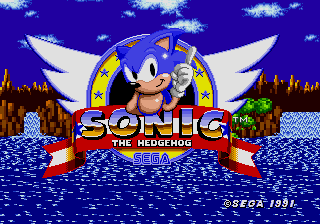
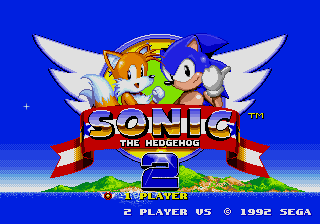
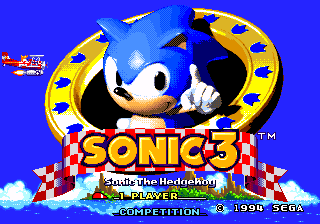
Look at that cool, smug face. That's it. That's the attitude.
As you can see in the videos above, Sonic's speed gives him the ability escape and dodge danger. Because Sonic can run really fast to escape most situations, he's developed a taunting attitude that allows him to play on the edge of danger. This is a large part of who Sonic is, yet his games are heavily weighed down with exploration, jumping, and a racing elements. If the player's main priority is to get to the end of the level or to shave off seconds from their race time, PLAY never becomes a significant part of the experience. PLAY is how a player expresses him/herself in a game system that's balanced to include player controlled difficulty, momentum, flow, and superfluous actions.
Basically being able to goof off and still get the job done captures that "I'm untouchable" Sonic attitude. PLAY is something that players naturally seek. Even games as serious and competitive as fighters feature taunts. Super Smash Brother's Brawl features 3 taunts per character (1:50), and this doesn't even include the taunts that players have made up. When expressing yourself, anything can be a taunt. And in the absence of an included taunt, players make up their own. In Halo, players use the CROUCH mechanic to kneel over fallen enemies, to dance, and communicate to each other in a primitive Morris code. Everything in a game shouldn't be about strictly reaching the goal. This sense of freedom of expression, movement, and PLAY is what the Sonic Beyond must capture.
Perspective
In a video game, visuals are of the utmost importance. If you can't see what's going on, you're left with using only 20% of your sensory perception, which isn't enough for most games. Along these same lines, if you can't seen the game with enough time to process the information and make an informed decision, a stress is put on the entire dialog between the game and the player.
The 2D Sonic games are too zoomed in making it hard for players to successfully navigate as well as build the bigger picture of the level in their minds. Sonic Beyond must change its game perspective so that more is visible. Sonic Unleashed uses the wide screen to increase the horizontal view compared to the classic games (see above). Unfortunately, the vertical view is about as limited as before. The Sonic Rush series is the exact opposite. The DS allowed for the Sonic Rush games to open up the vertical view, but the dual screens couldn't help the increase the horizontal view limitations. Though the RUSH mechanic can keep players safe from running into a sudden enemy, it also increases the speed of the game, which is a dangerous trade off. As silly as the suggestion may seem considering how much I appreciate the dual screen gameplay design of the Sonic Rush games, Sonic Rush would really benefit from a map screen.
There are a few solutions Sonic Beyond can take. The entire 2D level can be projected onto a large screen or a wall so players can literally play on the big picture with everything in sight and no surprises. Though this idea is intriguing, it's silly and impractical. Another clever solution is the game can automatically zoom out as Sonic increases in speed. The faster you go, the more you'll be able to see ahead of you, and the more time you'll have to react. The problem with this idea is that players will lose track of Sonic and other small details as the screen zooms out. At high speeds, the ratio of Sonic to screen would put a great stress on the player's eyes and the overall balance of the game presentation. The more the camera zooms out, the more non pertinent level elements creep into the game view. Because you wouldn't be able to interact with many of these extra elements when the camera is zoomed out, they would do more harm than good cluttering up the visual presentation.
The final and best solution is simply making Sonic Beyond a 3D game. The 3rd person camera is ideal for displaying a variable amount of a 3D level. Whether pulled back behind Sonic along the ground, up above looking down, or to the side creating a classic 2D side scrolling perspective, the flexibility is undeniable and essential. Mario Galaxy pioneered the tech and now Sonic must follow in Mario's footsteps. There is simply no other way to get around the limitations of the 2D Sonic presentation.
Sonic the Man, the Ball, and the Pin Cushion.
Sonic Beyond is designed with a clear and functional difference between each of Sonic's 3 states: Man, Ball, and Pin Cushion.
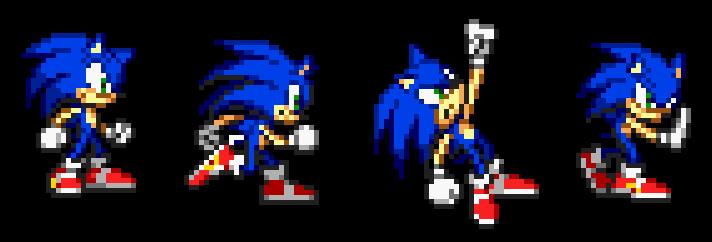
When Sonic is unballed, he stands upright on two legs like a man. In this form, Sonic is free to use his hands to grab onto objects. In man form Sonic has the most control over his direction and momentum when running. Sonic can also jump the highest when in this form. The biggest draw back to man Sonic's high maneuverability is vulnerability. In man form, Sonic can be hurt easily.
The most interesting design feature for man Sonic is that his speed gradually accelerates. This mechanic is very similar to the RUN mechanic in Okami and Devil May Cry 4. This design will influence players to view, process, and maneuver around the game world to prevent any slip ups, slow downs, or stops in order to preserve momentum. In this way, Sonic Beyond's RUN mechanic achieves a similar level dependant chaining system that Sonic Rush has without using an abstract game mechanic.

When Sonic curls up into a ball, all of Sonic's properties and abilities change. Basically, when Sonic turns into a ball, he acts like one. This includes bouncing off of objects and rolling down hill more quickly than Sonic can run downhill. Bernoulli's principles of fluid dynamics also applies to Sonic in ball form. In other words, Sonic should be able to curve through the air like a baseball/tennis ball/soccer ball, roll around obstacles like a bowling ball, change direction after hitting the ground like a tennis ball, and create lift like an airplane wing.
All of these abilities greatly distinguish Sonic the man and Sonic the ball. To create a balance between the two so that both are functionally useful in a variety of situations, the ball form of Sonic needs limitations. Unlike in previous Sonic games, in Sonic Beyond ball form Sonic won't be able jump as high or control direction and momentum as well as man Sonic. In addition, Sonic Beyond won't feature a SPIN DASH or RUSH mechanic to give the player instant speed. Sonic Beyond is all about understanding the relationship between speed, momentum, control, and space. To do this players have to understand the difference between having legs (man Sonic) and rolling around (ball Sonic). This design also creates gameplay that relies on potential energy. To reach high places, players have to platform vertically in man form. To turn the potential energy into horizontal speed players must use the ball form. Man form has reduced air control. Ball form has reduced sticking ability when landing. The pros and cons complement each other.

Sonic, being a hedgehog, has the incredible ability to expose his spines. This means he can be smooth like a ball, or dangerous like a pin cushion. Like in Sonic 3, in Sonic Beyond Sonic is able to quickly flare his spines. Doing so when coming into contact with an enemy creates an attack. Flexing Sonic's spines when colliding against a wall Sonic gives players the ability to tech or ukemi to stop in place instead of bouncing or rolling away.
Level design
There are two things that really distinguish the platforming in 2D Mario vs 2D Sonic. Both have a factor of momentum that is well tuned for each game. Both have a sense of speed and flow. However, when standing on a hill/incline/slanted surface Mario jumps straight up while Sonic jumps perpendicular to the surface. This difference allows Sonic to run and platform off of the ground as well as ceilings and walls. This simple physics based feature made the Sonic paltformers much more receptive to curved and hilly level design. It's no wonder the loop is one the lasting hallmarks of Sonic level design seeing how it emphasised momentum and this perpendicular jump feature. The hills in Sonic are also emphasised by Sonic in ball form. Mario has nothing like the ability to rolling down hill. At best Mario can only slide.
Fortunately for Mario, the other distinguishing feature of his 2D platforming design is that Mario and all the enemy/level elements are quantified to the brick unit. This quantification makes not only all of Mario's gameplay fit together like Legos, but it is instrumental in communicating to the player. Because Sonic is so comparatively analog both in the size of the enemies and the design of the level elements, the platforming challenges were less precise and more open.
The levels in Sonic Beyond must be simple with a strong sense of organic unity. Like in Super Mario Galaxy, a level can be as simple as getting to the top of a single mountain. With Sonic Beyond's 3D level design, the player is free to get from point A to point B in a variety of ways. The 3D design naturally yields itself to creating alternate paths. Additionally, the abstract timer that encourages players to move through a level quickly in the classic 2D Sonic games is replaced with organic timers. Instead of being encouraged to reach a point before the timer hits 0 because the game will kill you, players will have to reach a point because of some tangible conflict like the bridge is about to break, the cave is about to collapse, the ring will soon fall over the waterfall, or Robotnik is getting away. In these scenarios, the stakes are clear, the timing is obvious, and the consequences are real. If you don't catch Robotnik now, you know you'll have to face him later. In fact, the threat of drowning underwater in the classic Sonic games and the interplay grabbing air bubbles is a great example of an organic timer.
Sonic Beyond implements more advanced types of level design including folded, accordion, and pure organic. The basic idea is that even the fastest thing alive can't be everywhere at once. The Flash and Super Man are often put into situations where they have to struggle with the reality that even they can't be in two places at once. In Batman: The Dark Knight, the Joker set up a similar scenario for Batman forcing him into a situation where he could only save one of two hostages. It is this dynamic and the juggling of events separated by space that Sonic Beyond focuses on.
Enemy Design
Many of the Enemies in Sonic Beyond are designed to function more like toys/obstacles than harmful weapons. When a game is designed with more than one way to win, the game elements (level/enemy) have more range to work with. In Advance Wars, players can win by capturing the enemy's base, destroying all of the enemy units, and/or capturing enough properties. In Pikmin 2's battle mode players can destroy the opponent's avatar, destroy all of the opponent's Pikmin, capture 4 yellow marbles, or capture the opponents special red/blue marble. With so many ways to win, strategies can become more varied than simply optimizing toward achieving the one goal.
In Sonic Beyond, some enemies are designed to slow Sonic down rather than hurt him. Other enemies transform the level over time to Sonic's disadvantage. For example, if an enemy was busy cutting the ropes on a bridge, if Sonic doesn't get there in time players will be forced to find another way across the chasm.
Like in the second video above, enemies should be designed to give players something interesting to do. Each enemy can be designed so that Sonic can handle them using unique, contextual attack strategies like in God of War. But instead of reducing the game to a simple quick time event, the gameplay will remain dynamic and ultimately in the player's control.
Ring Design
In the same way the number and grouping of the coins in the 3D Mario games had to change because of the increased visual range due to the camera system, the ring design of 2D Sonic doesn't translate well into 3D. Because dying and getting hurt in Sonic Beyond is greatly diminished, holding onto lots of rings would be less important. Instead of sprinkling rings all throughout the levels of Sonic Beyond, the rings are few, far between, and carefully placed in the levels to create platforming challenges.
To sum up, fixing the core Sonic design issues starts with a few changes that subsequently changes the whole game. The evolution is as follows:
- The 2D side scrolling perspective had to be expanded into 3D to achieve a flexible camera/perspective solution.
- Following in Mario Galaxy's footsteps, the way a character interacts in a 3D world provides a layer of engagement which allows for a game to feature less enemies and a more detailed action.
- To match the level of detail that is an inherent part of 3D games, Sonic's core abilities were redefined to complement each other, taking up a unique design space for Sonic the man, ball, and pin cushion.
- To reduce the clutter of the old ring design, the dependency for rings as health has been removed. Following this design decision, the ring count can be greatly reduced making each ring (placement and obtaining) more significant.
- To make better use of the 3D space the levels and the challenges are designed to fold on themselves creating pure organic challenges.
- The abstract timers (clocks) of the old Sonic games are converted into dynamic organic timers (scenarios).
- Because the level in are folded and the goals are organic, the enemy design is free to explore design spaces other than simply giving Sonic damage.
That's it for my Sonic repair. I have more specifics on the game, but they're not relevant to the core topic of this series. After all, I'm not actually working on the next Sonic game. Now that I understand Sonic, I can finally put away the old Sonic vs. Mario issue and stop playing Sonic Rush Adventure. I see more sloppy games in Sonic's console future. And that makes me wish for the game that would take Sonic beyond.
